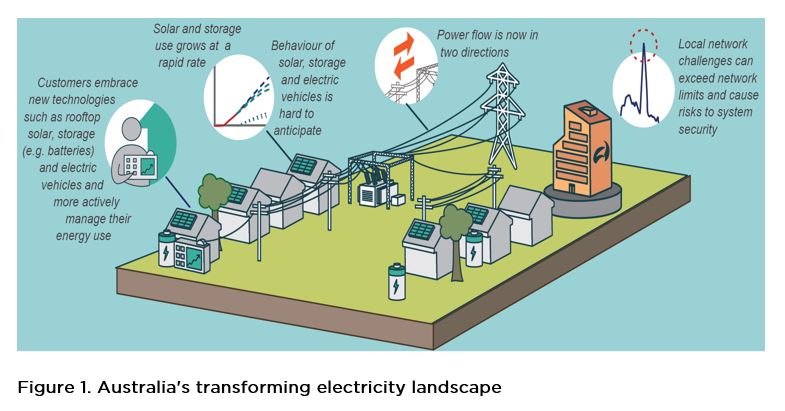Big data, big deal
The energy world is changing rapidly. This transformation is being driven by shifting customer needs, the increase in new distributed generation sources and technology advancements. As a result, data collection and exchange are growing exponentially, creating digital threats but also valuable opportunities for industry stakeholders and customers. Data is abnormal in that its value is driven by abundance not scarcity. To thrive in this transforming landscape, the utility of the future will need to evolve into a fully digital system.
Ensuring an affordable and reliable transition to a future grid

Data transmission channel. Motion of digital data flow. Transferring of big data.
Australian electricity networks have always had to handle vast amounts of relatively stable, structured data. However, in a transforming landscape, this will increase significantly as continual, large volumes of high velocity, varied information flows become available from multiple sources. The question networks, AEMO as the system market and system operator and other key businesses and stakeholders need to answer is what benefits can this wealth of new information provide and how can they be best extracted.
To answer that question, we need to understand the veracity of the data and the potential value it holds. Essentially, ‘Big Data’ in its raw form is worthless. Any associated benefit from data can only ever be realised where we have confidence in its quality, the ability to rapidly combine it and to then apply advanced analytical techniques that deliver insights. Only then can we facilitate better and faster decision making that will release value to all parts of the energy value chain.
For distribution network operators, those benefits will only be released by optimising how we develop and operate the distribution network, maximising the potential capacity of our existing equipment and allowing us to increasingly target how, when and where we upgrade the network. This ultimately means lower costs for customers by removing the need to spend money on traditional network reinforcement like new poles and wires and substations.
The move to distributed energy
Distributed energy resources such as household solar and storage are smaller sources of generation that if aggregated, can provide the power necessary to meet regular demand, as well as deliver services, such as frequency response.
In addition, by better utilising evolving information and communication technologies, it is possible to unlock extra capacity from previously latent and passive resources, such as power load flexibility (i.e. demand side response).
However, the opportunities for distributed energy resources to create and provide greater technical and commercial value go far beyond basic aggregation, demand-response and load-shedding. In fact, if enabled they can perform many other functions critical for the power grid’s reliability and can tap into multiple value streams. For example, aggregating, managing and placing distributed energy resources into ancillary services markets. These services span short-term operating reserve, static, dynamic and enhanced frequency response.
To release this value from distributed energy sources, visibility to these systems and access to data is crucial. The speed, accuracy and reliability of a distributed energy resource’s ability to respond to the grid’s frequency variations is approaching that of large-scale conventional power plants. In addition to providing the above-mentioned services to the centralised power system, distributed energy resources can also be optimised to support and create value in medium and low-voltage distribution networks. This value comes in the form of avoided or deferred investments in wires and transformers in areas where they can serve increasing loads.
The Transformation
The Open Energy Networks Project (OpEN) is a major initiative led by Energy Networks Australia in partnership with AEMO. OpEN is an industry-wide project investigating the move from traditional distribution network operations delivering electricity from power plants to people’s homes, to a much more complex system managed by a Distribution System Operator (DSO) for a whole range of technologies that generate, consume and manage electricity. The volume and complexity of data that will be exchanged in this new environment will create the need for innovative approaches to data visualisation, synthesis and sharing. Analysing data the right way will enable us to interpret and act on the wealth of information that will be available to the DSO.
A key point identified in the OpEN project is the need for visibility of conditions on the network. As the energy transformation continues to evolve, it will become more important than ever to ensure that networks are able to easily adapt toward dynamic operation of energy flows throughout their distribution system.

Connection point data allows networks to stay ahead of the affordability and reliability curve by developing key competencies in distribution system operation. The OpEN project has identified four core areas of development within networks that are essential over the next decade that will be aided by access to connection point data, including:
- Modelling hosting capacity across the network: using real time profile data to establish voltage and thermal constraints at localised feeder levels, given different penetration levels of PV.
- Determining network constraints: developing a method that calculates the operating envelope from the technical network data (i.e. a set of constraint equations, modelling etc.).
- Defining operating envelopes: establishing these constraints in a form that can be communicated to all appropriate stakeholders.
- Publishing or communicating the operating envelopes: defining protocols for envelope communication to markets and all key market actors.
The OpEN consultation process has found that without these required capabilities in place, it will not be possible to ensure network integrity when DER market participants seek to offer a range of services to the market, particularly as DER penetration rates increase. This is equally the case for generation such as solar PV and loads such as electric vehicles or storage, as the operating envelopes will allow for both positive and negative values.
Issues
As well as presenting great opportunities, there are potential risks that will need to be resolved to safely release the value of big data. These challenges include:
Technical: Significant investment is needed in the IT/IOT infrastructure and applications that are required to ingest, integrate, store, analyse and publish the vast data streams that big data introduces. Also, in regard to meter data, there is an expectation that the type, resolution and frequency of connection point data from smart meters meets the needs of customers, retailers and networks, when in fact, these needs are different. The minimum meter specifications under Australia’s Power of Choice rules focus on the needs of billing and settlement and do not provide what networks require.
Data Quality: Data that may have been fit for purpose when collected or created, may not be so now. Equally, where we receive data from external sources, networks may have little or no control over its quality. As with any form of analysis, data quality has the ability to compromise the effectiveness of big data analytics.
Access: Networks will have an increasing reliance on data over time to ensure an affordable, reliable and flexible grid. However, the access to meter data and associated funding to enable this has not been formalised. This may result in significant delays, or even limit the future role of networks as the energy transformation changes relationships between different segments of the market.
There is also a preconception by some stakeholders that connection point data is already available to meet networks’ needs, when in reality penetration of smart meter infrastructure is still low across most of the country.
Analytical: There is an assumption that network benefits immediately accrue once access to data is provided, but significant time and investment is required to deliver those benefits. Also, individuals with the talent and skills to manage, assimilate and utilise big data are rare. Insourcing and upskilling is of the utmost importance.
Cyber Security: Accessing, utilising and providing multiple internal and external data streams increases risk to network and control systems that will have to be managed.
Social Acceptance: To attain and retain acceptance of the use of big data, it is paramount customer privacy is maintained and benefits are quantified and well-articulated.
In future, networks will need to work with meter providers and other key stakeholders to develop new solutions for future problems and innovation will be required to devise increasingly unique solutions for the sector based on the application of big data.
Big data is no silver bullet that will transform the industry overnight, but it is a key source of endless potential benefits that will only be realised if the industry works collaboratively to identify and exploit the opportunities, taking the most valuable insights and, most importantly, acting on them.

